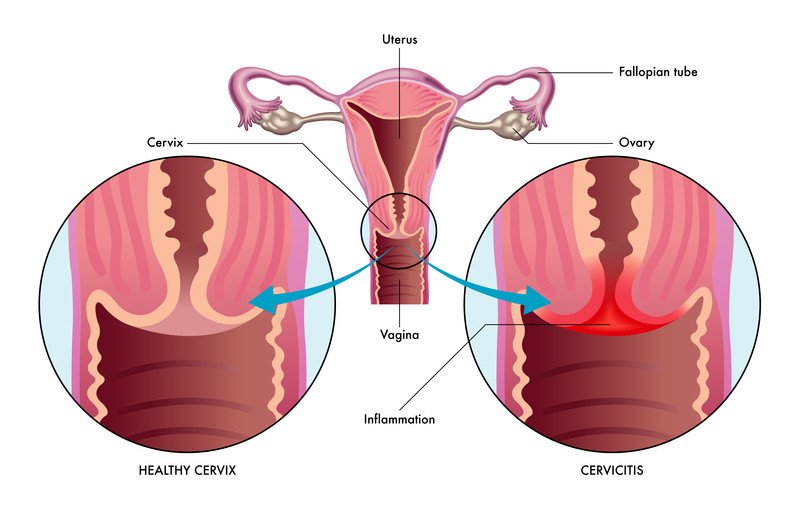Cervicitis
Medically reviewed by Drugs.com. Last updated on Jul 17, 2023.
What is Cervicitis?

The cervix is the donut-shaped opening to the uterus. Cervicitis is an inflammation and irritation of the cervix. Symptoms of cervicitis can be similar to vaginitis, with vaginal discharge, itching or pain with intercourse.
Cervicitis can be caused by a sexually transmitted infection. Most common are chlamydia and gonorrhea. Trichomoniasis and genital herpes can also cause cervicitis. In some cases, cervicitis is not caused by infection. It may be due to trauma, frequent douching or exposure to chemical irritants.
Symptoms
Cervicitis often causes no symptoms at all, but some women will experience pain during intercourse, vaginal itching, a bloody vaginal discharge, or vaginal spotting or bleeding between periods (usually after vaginal intercourse). If the urethra (urine tube) also becomes infected, you may feel burning when you urinate or you may urinate more often. Cervicitis can spread to your uterus, fallopian tubes or ovaries, which is a condition called pelvic inflammatory disease (PID). If you have PID, you may have abdominal pain or fever.
|
|
Diagnosis
Your doctor will ask about your medical history and whether you have any new sexual partners. He or she will do a pelvic exam to look at your cervix. This is done with a device called a speculum. This is a metal or plastic device shaped like a duckbill that holds the vagina open.
If you have cervicitis, the lining of the cervix may appear red, inflamed, swollen or irritated. In more severe cases, pus may be coming from the cervix. During the pelvic exam, your doctor will take a sample of discharge or pus from your cervical opening so it can be tested in a laboratory and examined under a microscope to determine if you have an infection such as gonorrhea, chlamydia, trichomoniasis or genital herpes. He or she may also check for yeast or bacterial vaginosis. These infections can cause similar symptoms, though they affect the vagina rather than the cervix.
Your doctor also will examine your pelvic area using his or her fingers to look for tenderness of the cervix, uterus or ovaries. To do this, the health care professional will place his or her fingers inside your vagina. Be sure to tell your doctor if you have a latex allergy before he or she puts on gloves for the examination.
If your cervix, uterus or ovaries are tender, it's possible you have pelvic inflammatory disease (infection of the uterus, fallopian tubes or ovaries) in addition to cervicitis.
Expected duration
Once cervicitis is diagnosed and the appropriate treatment is started, symptoms should start to improve within a few days. If there are any signs of PID, you will need to take antibiotics for two weeks.
Prevention
Cervicitis most often is caused by a sexually transmitted infection, so it is important to use a condom every time you have sex and to limit the number of sexual partners you have. If you are diagnosed with a sexually transmitted infection, your recent sexual partners also should get tested and treated.
Treatment
Treatment is guided by the type of infection you have. If you have risk factors for a sexually transmitted infection, such as unprotected vaginal intercourse with a new or multiple sexual partners, or if the physical examination suggests you may have cervicitis, you may start treatment with antibiotics before the test results come back.
Gonorrhea is usually treated with an injection of the antibiotic ceftriaxone (Rocephin) and one dose of oral azithromycin. Chlamydia is typically treated with oral antibiotics, such as doxycycline (sold under several brand names), azithromycin (Zithromax), or levofloxacin (Levaquin). Trichomoniasis is treated with the antibiotic metronidazole. If you are allergic to any of these antibiotics, an alternative can be prescribed.
If you have genital herpes, an antiviral medication can be prescribed. This could be acyclovir (Zovirax), valacyclovir (Valtrex) or famciclovir (Famvir). You will need to take the medication for up to 10 days the first time you develop genital herpes. For recurrent herpes outbreaks, you can take the medication for three to five days.
If you are diagnosed with a sexually transmitted infection, it is important to tell any recent sexual partners that they must see a health care professional for testing and treatment.
Cervicitis caused by trauma or an IUD is treated with an antibiotic targeted to the type of bacteria. The associated inflammation will heal within days to a few weeks. It will help to avoid sexual intercourse until symptoms improve to avoid any further irritation to the cervix.
Treatment options
The following list of medications are related to or used in the treatment of this condition.
When to call a professional
If you have recurring pain during intercourse, a new vaginal discharge or discharge that has changed in color, or if you have vaginal spotting or bleeding between periods, you should make an appointment to see a health care professional.
If your symptoms also include fever or abdominal pain, see a health care professional as soon as possible.
Prognosis
Cervicitis will go away within a few days to a week after you start taking antibiotics. If you have pelvic inflammatory disease, it may take a few weeks to treat the infection completely. Pelvic inflammatory disease can cause more serious problems, such as infertility or pain from scar tissue. Although these additional conditions can be treated, they sometimes require surgery.
Cervicitis rarely comes back if it is treated with the appropriate antibiotic, unless you get a new infection from a sexual partner. Genital herpes cannot be cured. However, if you develop recurrent disease, you can decrease the frequency and severity of outbreaks by taking an antiviral medication.
Additional info
Centers for Disease Control and Prevention
https://www.cdc.gov/
Further information
Always consult your healthcare provider to ensure the information displayed on this page applies to your personal circumstances.

